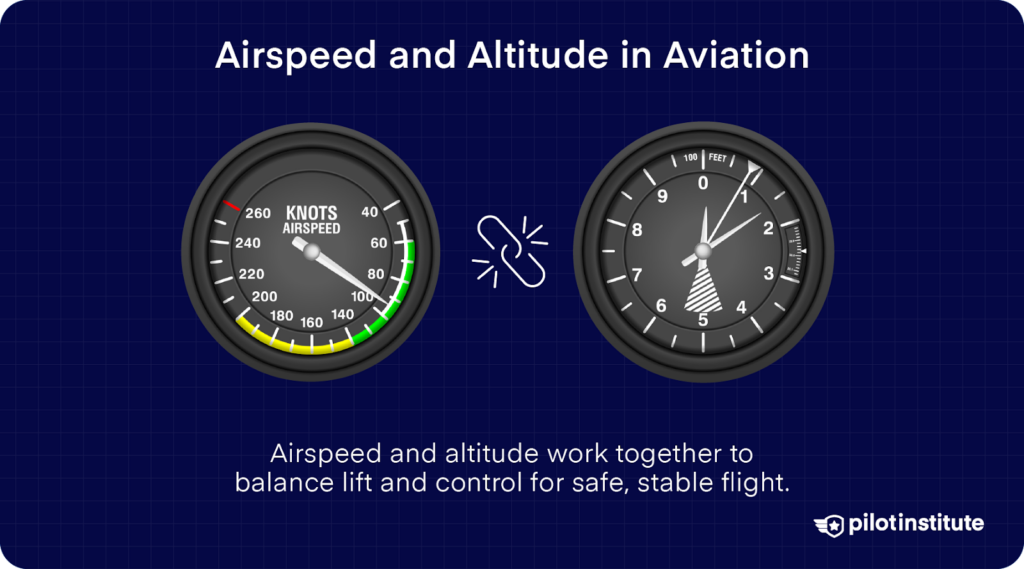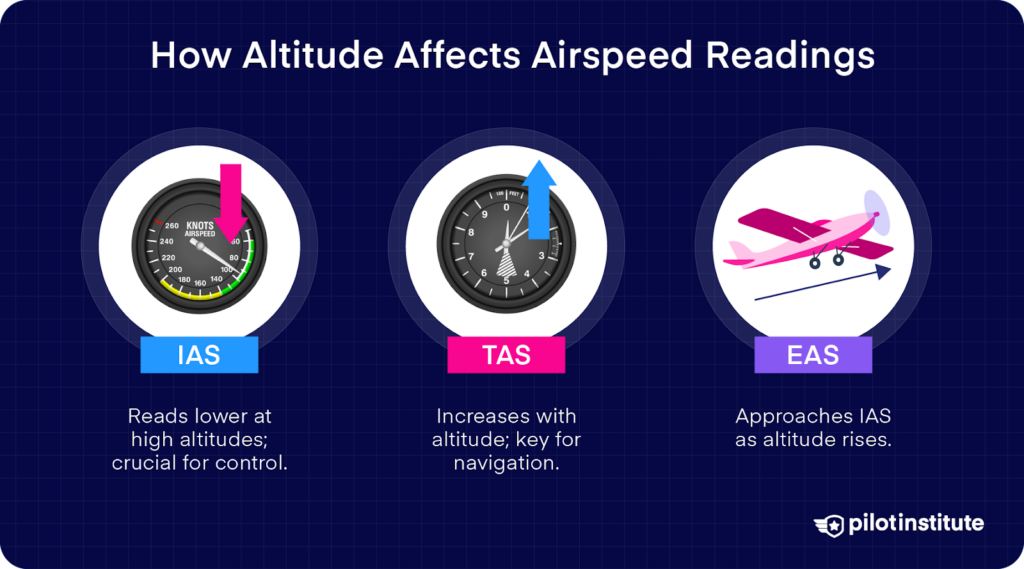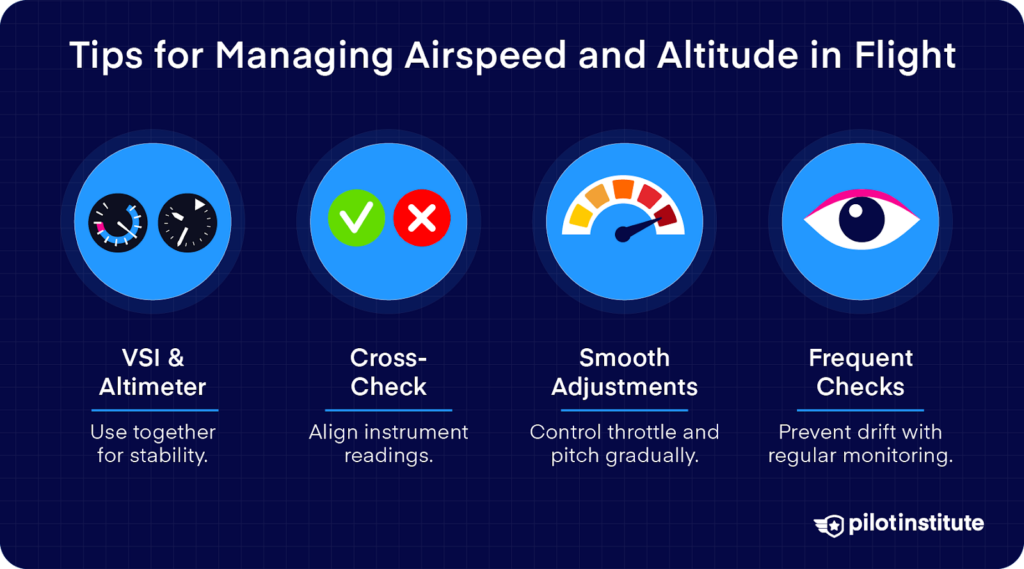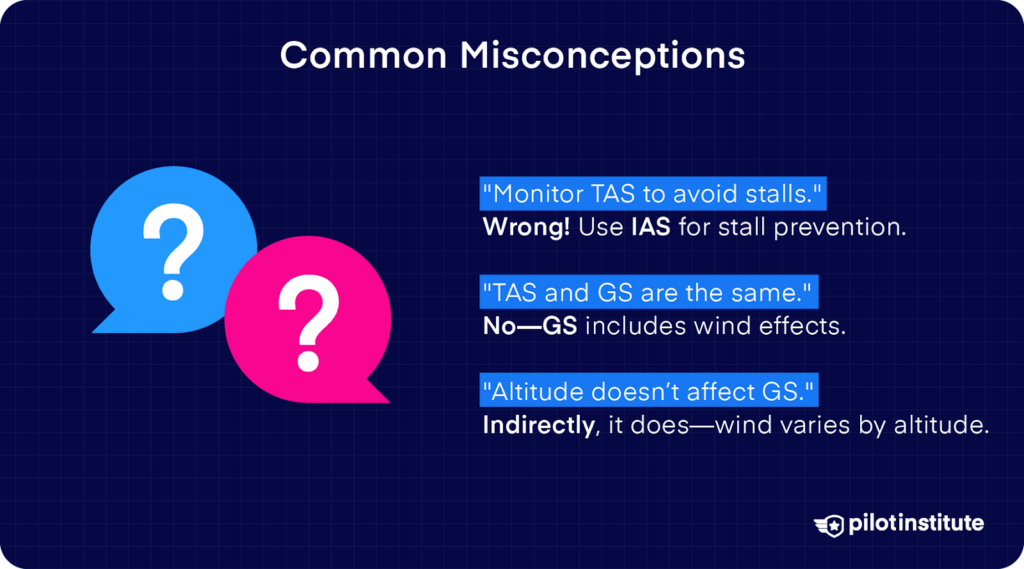-
Key Takeaways
-
Understanding the Basics of Airspeed and Altitude
-
Types of Airspeed and Their Importance
- Indicated Airspeed
- Calibrated Airspeed
- True Airspeed
- Equivalent Airspeed
- Ground speed
-
How Altitude Affects Airspeed Readings
- Indicated Airspeed and Altitude
- True Airspeed and Altitude
- Equivalent Airspeed, Compressibility, and Altitude
-
Tips for Managing Airspeed and Altitude in Flight
- Using the VSI and Altimeter for Stability
- Cross-Checking Your Instruments
- Airspeed & Altitude Tricks
-
Common Misconceptions and FAQs
- Airspeed & Altitude FAQs
-
Conclusion
Want to make sense of how altitude affects your airspeed? Wondering why your instruments seem to change as you climb?
Then keep reading!
If you’re aiming to get comfortable with managing both airspeed and altitude in flight, you’ll need to understand the difference between indicated airspeed (IAS) and true airspeed (TAS).
But what exactly changes as you gain altitude?
We’ll explain how each type of airspeed works, why altitude makes a difference, and how to adjust for the best performance at higher altitudes.
So, if you’re ready to clear up the confusion around airspeed and altitude, let’s start!
Key Takeaways
- Airspeed and altitude are directly linked to each other throughout different phases of your flight.
- Your speed can be measured in different ways, including indicated airspeed, true airspeed, equivalent airspeed, and ground speed.
- Air pressure and density decrease as you climb, which can affect the accuracy of your airspeed readings.
- Combining the data shown on your cockpit instruments helps you make better judgments.
Understanding the Basics of Airspeed and Altitude

You’ve probably heard of airspeed and altitude, but they’re actually more connected than you think!
Airspeed and altitude are two core concepts in aviation. You must constantly monitor them to ensure a safe, efficient flight.
First things first, let’s settle on what each of these concepts means.
Airspeed refers to how fast your aircraft moves relative to the air around you. It’s typically measured in knots (nautical miles per hour), with one knot being about 1.15 miles per hour.
The faster an aircraft goes, the more lift it generates. Lift is the upward force that keeps you in the air.
You rely on airspeed to control your aircraft’s movement. If airspeed is too slow, the aircraft could lose lift and stall. But go too fast, and you’ll have a harder time with controls and might even end up damaging the aircraft.
The bottom line? Proper airspeed management is the first step in taking control of your aircraft.
There are different types of airspeed, each serving a specific purpose. One example is Indicated Airspeed (IAS), which is the airspeed you read directly from cockpit instruments.
Altitude, on the other hand, is the aircraft’s height above the ground or sea level. It’s usually measured in feet.
Proper altitude management ensures that you navigate safely. It lets you stay clear of mountains, buildings, and other aircraft.
How are airspeed and altitude connected to each other?
Airspeed and altitude work hand-in-hand to create balanced control. This is especially important during take-off and landing.
Higher altitudes, where the air is thinner, require adjusted airspeeds for stable flight. Meanwhile, lower altitudes demand that you be extra careful with airspeed to maintain lift and prevent stalls.
You should understand these elements to maneuver safely and adjust to different flight conditions.
Types of Airspeed and Their Importance

Did you know that airspeed can be measured in many ways? Depending on your aircraft’s position and the flight’s purpose, there are different types of airspeed that you should know about.
Let’s take a look at each one:
Indicated Airspeed
The indicated airspeed is the speed shown on your aircraft’s Airspeed Indicator (ASI). It works by reading the difference between static pressure and total pressure from air flowing into a pitot tube. This difference in pressure is called dynamic pressure, and it’s used to get the IAS.
IAS is a straightforward measure that helps you gauge how much lift your aircraft is generating. This is essential during takeoff, landing, and general maneuvering.
It’s essential for low-level and slow-flight scenarios. In these instances, you’ll want to constantly check if you have enough lift to stay airborne.
Calibrated Airspeed
Calibrated Airspeed (CAS) is your Indicated Airspeed (IAS) with a bit of extra accuracy added.
Sometimes, the way air flows around your plane or into the instruments can cause small errors in your airspeed reading. CAS fixes those errors so you know the real story.
You’ll notice these errors the most at high angles of attack, like when you’re taking off or landing.
For example, in a Cessna 172, IAS and CAS can be off by as much as 10 knots at slower speeds. But when you’re cruising, the two are usually much closer, often just a knot or two apart.
This means the difference between IAS and CAS isn’t always the same—it changes depending on your speed and how your airplane is flying.
That’s why CAS matters when you’re using charts to figure out things like takeoff or landing distances. It gives you the accuracy you need!
True Airspeed
As the name suggests, True Airspeed (TAS) is your aircraft’s actual speed through the surrounding air, corrected for altitude and temperature.
Ideally, true and indicated airspeed should be the same wherever you fly. But in reality, that’s not always the case. Why is that?
Remember that air density decreases as you climb. This change will cause the TAS to drift from your IAS, even if the instrument readings don’t change.
Equivalent Airspeed
Have you heard of air compressibility?
As an aircraft accelerates, especially at or above 200 knots, the air particles flowing around it become tightly packed. This causes a change in pressure, which can affect your airspeed readings.
In high-speed and high-altitude scenarios, like for military and commercial jets, compressibility affects the accuracy of your IAS.
In lower-speed, low-altitude flights, IAS and EAS are almost the same. However, as you climb or increase speed, the compressibility of the air distorts the readings in your instruments.
This is where Equivalent Airspeed (EAS) comes in. It is similar to IAS but includes a correction for air compressibility. It gives you a more accurate measurement when air compression affects your pitot-static instruments.
Ground speed
Ground speed measures how quickly you’re moving over the ground, taking wind into account.
It’s calculated by combining TAS with the wind speed and direction. A tailwind boosts ground speed, while a headwind reduces it.
Ground speed is important for navigation and trip planning since it represents your actual speed over the ground. This will directly affect your estimated arrival times and fuel calculations.
How Altitude Affects Airspeed Readings

As you climb higher, the air around you changes dramatically, especially when it comes to the air density.
But how exactly does that affect each type of airspeed? Let’s find out!
Indicated Airspeed and Altitude
Remember that the ASI uses dynamic pressure to measure your airspeed. The higher the dynamic pressure, the higher the reading in your ASI. But because the static pressure decreases with altitude, so does the dynamic pressure.
How will this affect your airspeed readings?
Well, this decrease in dynamic pressure causes your ASI to show a lower reading than your actual speed through the air.
Although that may be the case, IAS is still critical for certain maneuvers and low-altitude operations. It reflects enough dynamic pressure to maintain control, helping you know when a stall might be coming.
True Airspeed and Altitude
True airspeed is your aircraft’s actual speed through the air, corrected for the effects of altitude and temperature.
Since the air is thinner at higher altitudes, the aircraft needs to move faster to generate the same amount of lift it would at lower altitudes.
But because your aircraft encounters less resistance in the thinner air, your true airspeed will increase with altitude, even if the IAS doesn’t change. That means you’re essentially flying faster than what you see on your instruments.
For instance, an aircraft maintaining a steady IAS at 30,000 feet will have a faster TAS than at sea level due to reduced drag from thinner air.
This is why TAS is often used for navigational purposes and fuel planning. It gives you a more accurate idea of the distance and time to your destination at cruising altitudes.
Equivalent Airspeed, Compressibility, and Altitude
Remember that equivalent airspeed factors in the effects of air compressibility. Well, As you climb and density decreases, these effects also decrease.
This is due to the air molecules being more spread out. At higher altitudes, your aircraft could experience a lesser aerodynamic load.
What does this mean?
As altitude increases, the difference between the EAS and IAS shrinks, meaning the two values actually get closer together!
Tips for Managing Airspeed and Altitude in Flight

So, it’s time to put all you know into practice.
In reality though, managing airspeed and altitude is easier said than done. Not only do you have to watch your instruments, but you also need to understand how they interact.
How can you do this? Here are some helpful ways to improve your controls!
Using the VSI and Altimeter for Stability
The vertical speed indicator and altimeter are your best tools for maintaining a steady altitude. Although they each provide specific information, using them together will give you a better picture of your stability.
- The altimeter, when set correctly, shows your actual height above sea level. It gives you an exact reference for maintaining a constant altitude.
When climbing or descending, check the altimeter frequently to ensure you’re on target. Small adjustments will help prevent unnecessary fluctuations in altitude.
- The VSI shows whether you’re climbing, descending, or level. A positive reading means you’re climbing, while a negative one indicates descent. If the VSI shows a steady zero reading, you’re in level flight.
Adjusting your throttle and pitch gradually can keep the VSI stable. Watch this closely to avoid any sudden and abrupt changes.
Combine these instruments, and you get a good snapshot of your current altitude and rate of change. They’ll give you instant feedback before you drift too far off your altitude. This allows for smoother control over your vertical position in the air.
Cross-Checking Your Instruments
When you rely on just a single instrument, you’ll get incomplete or inaccurate information. We’ve discussed the altimeter and VSI, so now, let’s add the rest of your instruments into the mix!
Cross-checking your airspeed indicator, VSI, altimeter, and attitude indicator ensures that your flight data is aligned. It’s a skill you’ll learn with practice, which can only lead to better stability.
Which readings should go hand-in-hand?
- Airspeed and VSI: When you adjust airspeed, your rate of climb or descent may also change. After making any changes to the throttle, check the VSI to confirm that you’re maintaining your desired rate.
- Attitude indicator and altimeter: Use the attitude indicator to maintain your desired pitch angle for level flight. Then, check the altimeter to confirm that you’re holding your altitude, or approaching the altitude you want.
- Tachometer for power settings: Keep an eye on your engine’s power setting. Higher power settings can make you climb unexpectedly, and lower power settings can cause a sudden drop. Take control of your power to stay at a consistent altitude.
Airspeed & Altitude Tricks
Of course, you’ll want your flight not just to be stable, but smooth as well. If so, you’ll also have to be smooth with your controls.
Want to know how it’s done? Here are some simple techniques you should practice:
- Smooth throttle adjustments: If you want to make changes to the power, keep them small and controlled. Doing this will prevent sudden shifts in altitude or airspeed. For example, if you’re leveling off from a climb, reduce the throttle gradually. This will prevent a sudden nose dip or loss of airspeed.
- Use your trim: After setting your desired speed and altitude, use the trim controls to reduce your workload. They’re there for a reason! Trimming reduces the need to constantly hold pressure on the yoke or stick, making your life much easier.
- Anticipate power and pitch changes: One of the first things you’re taught is that pitch will affect airspeed. In a climb or descent, this is just as true. As you reach your target altitude, level off slowly before your desired altitude. This is helpful during climb to avoid overshooting, and during descent to avoid an unintentional steep dive.
How does this look in real life?
Let’s say you’re climbing to 5,000 feet. Just before your altimeter reaches 5,000, start leveling off, then gradually adjust your pitch and power to transition to level flight. Once you’re holding that altitude, trim as needed to relieve pressure on the yoke.
But to keep your flight smooth and stable all throughout, here’s our biggest advice:
- Set specific check intervals: Regularly check your instruments, especially during climbs and descents. At VFR, take a look at your instruments every minute, even if everything seems good outside. Quick checks on the VSI, altimeter, and ASI can alert you about early deviations, letting you make adjustments on time.
Common Misconceptions and FAQs

Airspeed and altitude may seem like day-one ground school topics, but a lot of new pilots still get them wrong. You hear these misconceptions all the time, and it’s time to finally address them!
Here are some common misconceptions you should watch out for:
“I should monitor the TAS to prevent stalling.”
Dangerous mistake. You will stall when the indicated airspeed reaches the stall speed, not the true airspeed.
The stall speed reflects the dynamic pressure needed to generate sufficient lift, which is what actually matters for stalling.
And which airspeed type measures the dynamic pressure?
It’s the IAS. At higher altitudes, the TAS of a stall is higher, but you should always use the IAS as your guide for the margin above a stall.
“TAS and GS are the same.”
It’s easy to mix up the two, but they actually differ depending on wind conditions. TAS is the aircraft’s actual speed through the air, while GS is TAS adjusted by wind. This means that GS can change with tailwinds or headwinds.
“Altitude has no effect on my ground speed.”
While it’s true that altitude has no direct influence over your ground speed, wind conditions can vary at different altitudes. You can be flying in a headwind at 1,000 feet, which slows you down. But fly up to 2,000 feet, and you may encounter a tailwind, increasing your ground speed.
Also, remember that density decreases with altitude. This means less drag and faster ground speed.
Airspeed & Altitude FAQs
Is there anything you’re still confused about? This subject can be a little confusing, so it’s normal if you still have questions. Let’s take a look at some FAQs and our answers!
“How can I know my true airspeed and equivalent airspeed in flight?”
You can use a flight computer like an E6B or onboard avionics to determine your true airspeed. You can also do a rough estimation by adding 2% to your IAS for every 1,000 feet of altitude.
For example, if you’re flying at 90 knots IAS at 7,000 feet, your true airspeed will be around 102 knots.
For equivalent airspeed, you can rely on flight computers or specific charts in your Aircraft Flight Manual. Some high-performance aircraft also have avionics that calculate EAS directly.
“Can ground speed exceed true airspeed?”
Yes, GS can exceed TAS when the aircraft has a strong tailwind. Ground speed reflects TAS plus or minus any wind component. So, with favorable tailwinds, GS can be much higher than TAS.
“How does altitude affect my fuel consumption and speed?”
Higher altitude, with its lower air density, reduces drag on the aircraft. It means that you can travel faster (in TAS) while consuming less fuel. This makes high-altitude flight much better for fuel efficiency. Just be sure to maintain a safe airspeed and altitude.
Conclusion
Hopefully, now you understand the link between altitude and airspeed. But if you need a reminder, here’s a quick and easy way to remember the link:
- As you climb, thinner air changes how the instruments read: indicated airspeed (IAS) shows lower at high altitudes because it senses immediate pressure changes, not actual speed.
Memory Trick: IAS is lower @ high altitudes
- True airspeed (TAS) generally increases, meaning you’re moving faster through less dense air than it appears.
Memory Trick: TAS increases @ high altitudes
- Flying higher can cut fuel use and reduce drag, though it also requires fine-tuning, like adjusting your fuel mix for best performance in low-density air.
Keep learning and keep flying!



